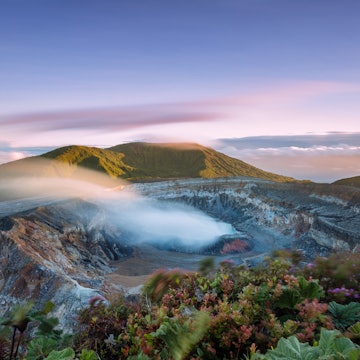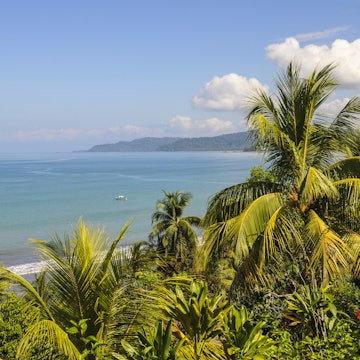
Sloths poop once a week - plus 7 other facts about sloths you didn't know

Oct 20, 2020 • 4 min read

From life-or-death trips to use the bathroom to cancer-curing fur fungus, there's a lot you don't know about the sloth © Emma Shaw / Lonely Planet
Who can't relate to the venerable sloth? They love warm climates, they can spend a whole day just chilling, and of course they're freaking cute. But there's also a lot of wild things you might not know about these fascinating animals.
To celebrate International Sloth Day, we put together eight weird facts about everyone's favorite tree-dwelling mammal.
They are what they eat
Sloths are known for their slow nature, but that’s due to the relatively low quality diet they consume. Most sloths eat a regimen of toxic leaves that provide little energy and can take up to a month to properly digest – in fact, if they digested any faster, the toxicity would poison them.
So sloths need to rest to do all that digestive work. They’ve been known to spend 60 percent of their day just sitting around digesting. And you thought you were lazy after Thanksgiving dinner.
Want to learn more interesting animal facts? Check out World's Wackiest Animals.
They’re great swimmers
Although sloth’s prefer living in trees, they’re great swimmers too. Their strong arms are made for holding onto branches, but are also well-suited for swimming. They can swim three times faster than they can walk on land.
Plus their ability to slow their heart rate down means sloths can hold their breath for up to 40 minutes underwater.

Pooping is life-or-death
Sloths are creatures of habit. They poop once a week and usually in the same spot. Their slow metabolism means they can go for long stretches between...movements... and they have to climb down to the forest floor to do so.
Because their weak hind legs make movement on the ground slow-going, that’s where they’re most vulnerable to predators. No wonder they hold it.
They have four-inch long fingers
Although they kinda look like claws, those long grabby bits are actually their finger bones protruding from the sloth’s paw. The bone is covered in a thin sheath of keratin, the same stuff our fingernails and hair are made out of.
These finger bones give the sloths an acute sense of touch, which probably helps since their eyesight is so poor.
Their organs are designed to work upside down
Sloths do almost everything in the trees – sleeping, eating and even giving birth! Their long claws are made for hanging from branches, so their internal organs are anchored to their abdomen to prevent stuff like the stomach, liver and kidneys from compressing the diaphragm, which would make it hard to breathe.

They can see behind their backs
Thanks to an extra vertebrae in their spine, sloths can turn their heads up to 270 degrees in either direction. Biologists aren’t sure why sloths evolved this unique trait, but the extra range of motion makes it easier to spot predators, and the specialized bones might provide extra neck support when hanging upside-down from trees.
They have a surprising family tree
The sloth’s closest living relatives are the anteater and the armadillo. All three animals belong to a group of animals called the Xenarthra (derived from the greek words “xénos” meaning “strange” and “árthron” meaning “joint”). These animals’ unique characteristics are largely due to evolving in isolation 80 million years ago when South America was still an island.
There was even an ancestor to the modern sloth called the Mylodon around 12,000 years ago that weighed over a ton and grew up to 10ft in length.
Their nasty fur could cure cancer
The sloth’s slow-moving nature and thick, coarse fur make their bodies prime habitat for a variety of algae and fungi. Biologists believe it’s a mutually beneficial relationship though – the algae gets a ready supply of moisture from the sloth’s fur, and the sloth gets some added camouflage. Moreover, researchers believe the symbiotic relationship goes further: some sloths have been known to eat the algae on their fur to supplement its otherwise poor nutritional diet.
In 2014 reachers said they found strains of fungus that could be used as potential treatments from ailments such as malaria, breast cancer and Chagas disease.

Where to see sloths
Sloths live throughout Central and South America. Costa Rica is home to two of the six subspecies of sloth – the two-toed sloth (Choloepus Hoffmanni) and three-toed brown sloth (Bradypus Variegatus). Although these sloth species can be found in the tree canopies all over the country, Parque Nacional Manuel Antonio, Limón, Monteverde, the Osa Peninsula and Arenal are great places to start.
Seeing sloths safely
Although it's tempting to want to hold the lazy little creatures, some studies suggest that kind of human contact is stressful for sloths. Moreover, those kinds of "animal encounters" can create a marketplace for poaching – tourist money exploits the animals and incentivizes their capture in the wild. In Costa Rica, it's illegal to hold, pet or touch sloths (or any wild animal). Find a knowledgeable guide to spot the animals in the wild, or choose a reputable wildlife sanctuary or rescue dedicated to the conservation of these fascinating animals.
You might also like:
Spend your days watching sloths at this luxury Costa Rican resort
Safari animals: the story of elephants (and the best places to see them)
Turning myth into reality: the white lions of Timbavati















